Archives
-
 Vol. 15 No. 2 (2024)Chaetodipus siccus liaae is a microendemic subspecies from the Planes basin, in the south of the Baja California peninsula. The subspecies is associated with deep sandy terrain and it has been determined that despite its small distribution area it is a very abundant species (Photograph Sergio Ticul Álvarez Castañeda)
Vol. 15 No. 2 (2024)Chaetodipus siccus liaae is a microendemic subspecies from the Planes basin, in the south of the Baja California peninsula. The subspecies is associated with deep sandy terrain and it has been determined that despite its small distribution area it is a very abundant species (Photograph Sergio Ticul Álvarez Castañeda) -

Vol. 15 No. 1 (2024)
Couple of grey brocket deer in a pond in Calakmul Biosphere Reserve. Grey brocket deer (Mazama pandora) are common inhabitants of the Yucatan peninsula forest in Southern Mexico and of the Northern forest of Guatemala and Belize. The species is a common prey for subsistence hunters of the area and prefer non-perturbed tropical forest of the area. The grey brocket deer is a quasi-endemic species with a limited distribution range. Scientific attention and conservation actions are necessary actions to conserve this amazing species of brocket deer (Photo Rafael Reyna-Hurtado). -

Vol. 14 No. 3 (2023)
Red ruffed lemur (Varecia rubra) taking a “sunbathe” during a crisp morning, this is a way of warming up their bodies. Red ruffed lemurs eat fruit, leaves, flowers, and nectar. This species can be found in the treetops up to 25 meters above the ground and are endemic to the northeaster Madagascar in Africa (photo of Sergio Ticul Alvarez Castañeda). -

Vol. 14 No. 2 (2023)
The mara (Dolichotis patagonum) also known as the Patagonian hare is actually a species of rodent (Rodentia) of the Caviidae family and has no relationship with hares (Lagomorpha). It is considered the largest rodent in the world, weighing up to 16 kg. Maras are endemic to the Patagonian plains of Argentina associated with semi-arid steppes and thorny bush deserts. They are a species considered vulnerable mainly due to habitat loss due to agricultural development and competition with European hares (Lepus europaeus). -
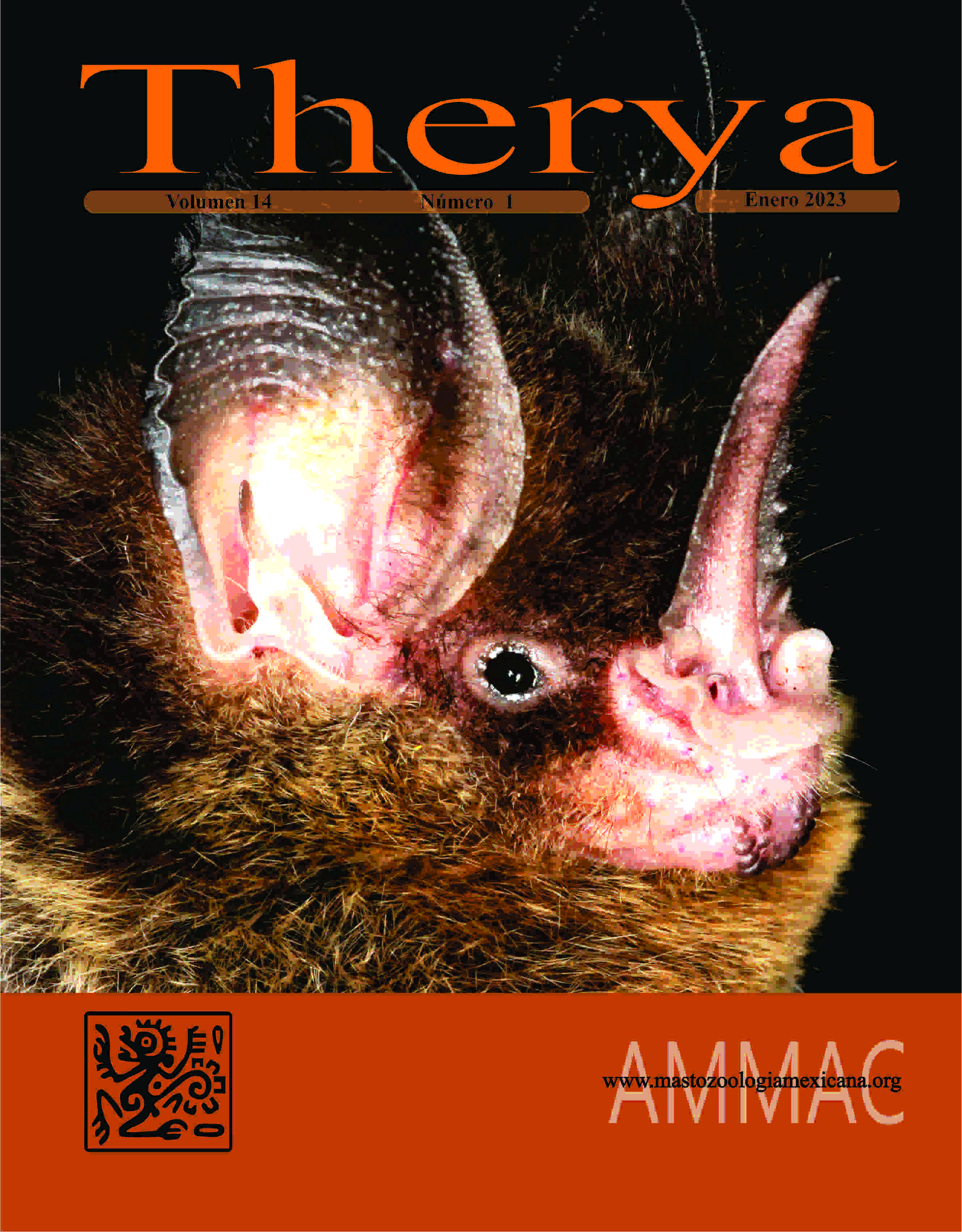
Vol. 14 No. 1 (2023)
The genus Gardnerycteris includes three neotropical bat species: G. keenani occurs from southeastern Mexico to northern South America, while G. koepckeae & G. crenulatum are found on east Andean slopes and the lowlands east of the Andes, respectively. Although these are uncommon and poorly known species, they apparently roost in small groups within tree cavities close to water bodies. They mainly feed on insects such as beetles, moths, flies, and hemipterans, but also on spiders, whip scorpions, small vertebrates, nectar, pollen, and fruits. Gardnerycteris was named to recognize Dr. Alfred L. Gardner’s important contributions to the knowledge of neotropical bats and this special issue of Therya is also intended to honor Dr. Gardner’s many contributions to our knowledge of mammals (photo by Marco Tschapka) -

Vol. 13 No. 3 (2022)
Nine-banded Armadillo (Dasypus novemcinctus) is possibly the most widely distributed dasipodid founding from North America to South America, and belongs to the Cingulata order. It is characterized by the presence of dermal shields that cover its entire body and are flexible in order to roll up itself for protection of its predators. The pattern of dermal shields is used as a characteristic of the different genera. It has big claws useful for dig its dens. In addition to its ecological importance, because its diet is omnivorous. Specially in Mexico, this species has several uses, the two most common are the consumption of its meat and the use of its shell, among other things for musical instruments or bags (photo taken by Sergio Ticul Álvarez- Castañeda). -

Vol. 13 No. 2 (2022)
The Gray fox (Urocyon cinereoargenteus) is one of the most widely distributed canids in North America, ranges in mainly all of the United States and México. There are only two species of this genus, the second is restricted to the islands off the state of California. Although foxes are of the order Carnivora, their diet is practically omnivorous and it is common to found a high percentage of plants and insects in its diet (photo taken by Sergio Ticul Álvarez Castañeda). -

Vol. 13 No. 1 (2022)
Microtus oeconomus, the tundra or root vole, is one of only four Holarctic rodents and the only species of Microtus found in tundra and taiga, grass and sedge communities on all northern continents. It has the northernmost distribution of any Microtus species in North America, with occurrences to 71° N in Alaska. Tundra vole populations often fluctuate in 3 to 4 year cycles throughout its range, but it is uncertain how climate change will affect its dynamics. It is an important prey item for avian and mammalian predators in northern ecosystems (Photo from Qikiqtaryuk Territorial Park (Herschel Island), Yukon, courtesy of Alice J. Kenney). -

Vol. 12 No. 3 (2021)
Hairy-legged vampire bat (Diphyla eucaudata) is found mainly on the slopes of the Gulf of Mexico southwardt to South America. It is considered that it feeds mainly on the blood from different types of birds. Within the vampire species, it is not very common among the three existing (photo: Sergio Ticul Álvarez-Castañeda). -
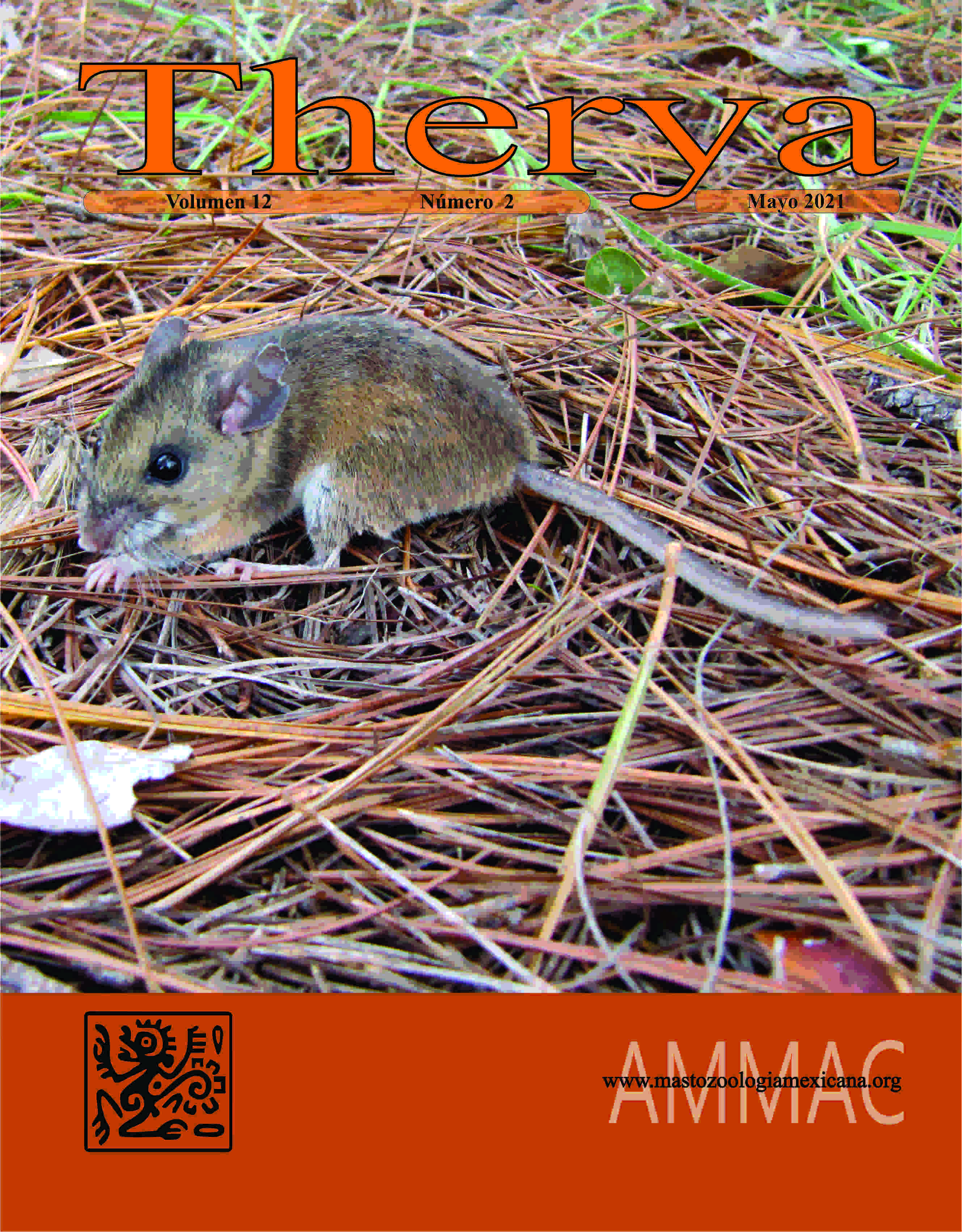
Vol. 12 No. 2 (2021)
The Schmidlyi´s deermouse (Peromyscus schmidlyi) is found in the states of Sinaloa, Sonora and Durango in the Sierra Madre Occidental of México at altitudes greater than 2,000 m a.s.l. Individuals are associated with vegetation where pines and oaks predominate in coastal scrub and chaparral. The species was described in 2004, in honor of David J. Schmidly, and it can be distinguished from other species in the genus by genetic analysis. Photograph taken from the Image Bank of the Comisión Nacional para el Conocimiento y Uso de la Biodiversidad (CONABIO), with reference number CLG0065. (Author of the photograph Celia López González). -

Vol. 12 No. 1 (2021)
The zapotero bat (Artibeus jamaicensis) is one of the most abundant bat species in the tropics of México and America. The species is characterized by its size and the presence of facial and malar lines on the face (photo: Patricia Cortés Calva). -

Vol. 11 No. 3 (2020)
The Bolivian chinchilla rat (Abrocoma boliviensis) is one of the most threatened mammal species in the world. This photo, is the result of several years of field work, showing an individual, possibly a female, being preyed upon by a Geoffroy cat. A. boliviensis was described by William Glanz and Sydney Anderson in 1990. However, so far, scientific information on the species is virtually non-existent. In this issue of THERYA, with articles dedicated to the memory of Dr. Sydney Anderson, a work dedicated to the ecology of A. boliviensis is presented showing that populations of the species still exist, apparently more or less healthy, in the center from Bolivia (photo: Carmen Julia Quiroga). -

Vol. 11 No. 2 (2020)
Green monkey (Chlorocebus sabaeus) from Barbados Island. The species -native to tropical Africa- has been domesticated and considered as a pet. Green monkeys were introduced at the end of the 17th century to different Caribbean islands mainly by slave ships from Africa. They are currently present on the islands of Saint Kitts, Nevis, Saint Martin and Barbados (photo: Sergio Ticul Álvarez Castañeda). -

Vol. 11 No. 1 (2020)
Lactating female juancito (Ammospermophilus leucurus) is the most common diurnal mammal species in the Baja California peninsula and various parts of the deserts of Northwest México. The image was captured inside the pronghorn conservation camp in Baja California when the individual friendly approached asking to be fed. In many regions of Baja California the junacitos interact much with the human population (Photograph by Sergio Ticul Álvarez-Castañeda). -

Vol. 10 No. 2 (2019)
Colonia reproductiva de lobos marino (Zalopus californicus) en la costa del Pacífico de la isla Margarita, Baja California Sur. Se observa como el macho del grupo vigila y se coloca entre los extraños al grupo y las hembras con crías (Fotografía Sergio Ticul Álvarez Castañeda). -

Vol. 10 No. 1 (2019)
Los Tuxtlas shrew, Cryptotis nelsoni, is one of the most threatened mammal species in México. This image not only symbolizes one of the peculiar characteristics of shrews -the pronounced snout- but also the very little thatstill known about this group of small mammals (Photograph by Lázaro Guevara). -

Vol. 9 No. 3 (2018)
The northern opossum (Didelphis virginiana) is a very common species in all tropical regions and recently has spread widely throughout North America, reaching Canada. Didelphis virginiana is a relatively abundant and very conspicuous species. Within it range is common to find individuals run over on the roads. The photo was taken on the border between Oaxaca and Chiapas (Photograph by Sergio Ticul Álvarez Castañeda). -

Vol. 9 No. 2 (2018)
Eastern hog-nosed skunk (Conepatus leuconotus) is one of the eight skunk species found in Mexico. Its range includes a large area of North America, including Mexico. C. leuconotus is relatively abundant and very conspicuous in the areas in which it inhabits. The species is constantly hunt without reason although in some places of Mexico its meat is considered as medicinal. Photo was taken in the plains at the Tehuantepec Isthmus (Photograph by Sergio Ticul Álvarez Castañeda). -
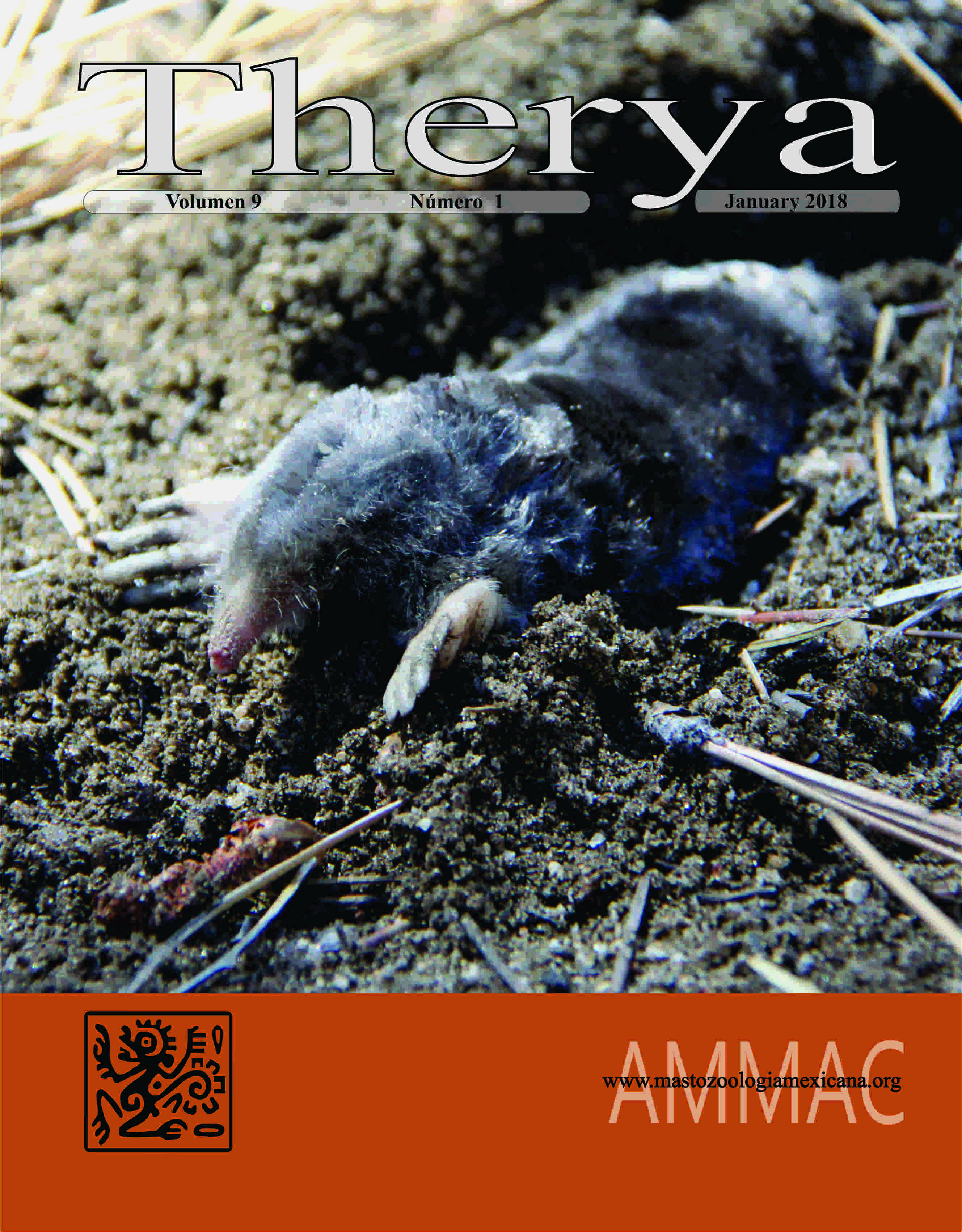
Vol. 9 No. 1 (2018)
San Pedro Mártir Mole (Scapanus anthonyi) is one of the three mole species found in Mexico. Its known distribution is restricted only to the upper parts of the Sierra de San Pedro Mártir in the state of Baja California. S. anthonyi is distinguished from the rest of the species of the Scapanus genus in its small size and having fewer teeth. Its observation is very difficult because of the gophers of the genus Thomomys in the same localities, so it is easier to find the galleries of the latter than those of the “Topo de manoplas” as they know it in the area (Photograph by Sergio Ticul Álvarez Castañeda). -

Vol. 8 No. 3 (2017)
The raccoon (Procyon lotor grinnelli) is one of the most abundant carnivores in North America, being frequently found associated with human settlements. This photograph shows three juveniles resting during a summer day on a dates palm. The palm tree offers protection, shade and food. Being in the high part offers good air circulation that helps to offset high temperatures. It is a subspecies endemic to the southern Baja California Peninsula. Photograph of a palm tree on the central plaza at Centro de Investigaciones Biológicas del Noroeste, La Paz, Baja California, Mexico (Photograph by Sergio Ticul Álvarez Castañeda). -

Vol. 8 No. 2 (2017)
The coyote (Canis latrans) is the most abundant carnivore in arid regions of North America. In areas where they are not hunted or chased, coyotes become very abundant and are the dominant predator. The coyote has a broad distribution range, from Central America to Canada. Photograph taken at Sierra de San Pedro Mártir, Baja California, Mexico, after an unusual snowfall during May 2017 (Photograph by Sergio Ticul Álvarez Castañeda). -
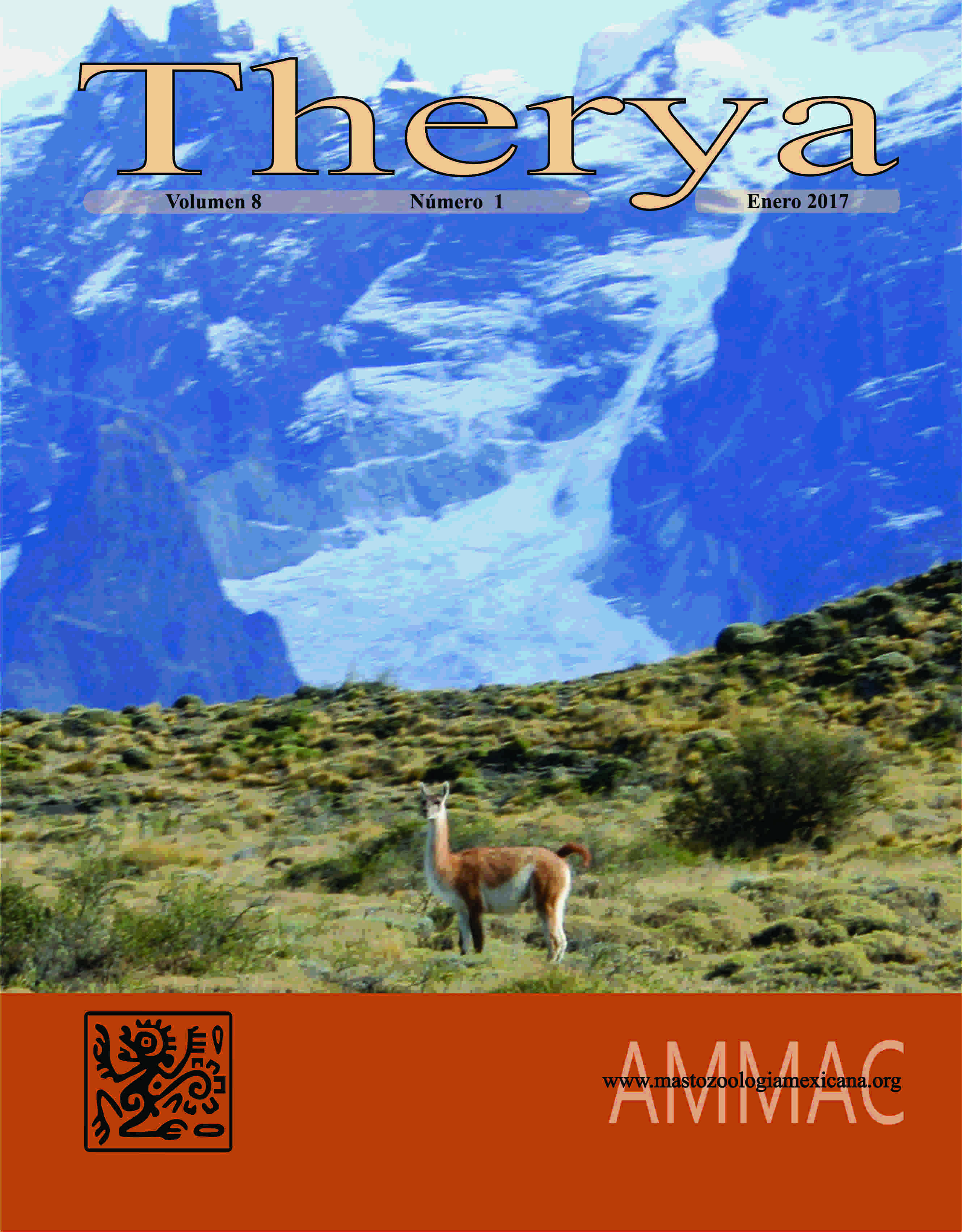
Vol. 8 No. 1 (2017)
Guanaco (Lama guanicoe) is one of the most representative species of the Andean regions of South America from Bolivia-Peru to Argentina-Chile. Picture taken in Torres del Paine, Chile, considered as one of the most beautiful regions in the world. In this region it is frequent to find large herds of guanacos in wild conditions (Photo by Sergio Ticul Álvarez Castañeda). -

Vol. 7 No. 3 (2016)
The kangaroo rat (Dipodomys merriami) is one of the most representative species living in desert regions of Mexico and southern United States. D. merriami is the species with the broadest geographic distribution, ranging from central Mexico northward to southern United States. This species has two populations restricted to the islands of San José and Margarita, both considered as endangered. These island populations include few individuals and are currently under heavy stress due to predation by feral cats (Photograph by Sergio Ticul Álvarez Castañeda). -

Vol. 7 No. 1 (2016)
Herd of deer (Odocoileus hemionus) in San Pedro Mártir National Park, Baja California, Mexico. Herd of more than 17 individuals that are grazing in the central valley of the reserve in the early hours of the morning. San Pedro Mártir is one of the regions of Mexico where I have been able to observe the largest herds of adult specimens. They are concentrated in this region because it is one of the few areas with grasslands in a desert environment (Photograph by Sergio Ticul Álvarez Castañeda). -

Vol. 6 No. 3 (2015)
Bison (Bison bison) at Armendaris Ranch, New Mexico, owned by Ted Turner. An adult male of this species can weigh more than one ton and, despite its robust appearance, can run as fast as 50 km/hr. Bisons are highly social, forming herds of more than 100 individuals. This species was driven to near extinction in North America in the early 19th century due to excessive hunting, mainly to sale its fur. Currently, in the grasslands of the Chihuahuan desert in New Mexico, the bison population is in full recovery, including more than 1,000 individuals (Photograph by Jonathan G. Escobar Flores). -

Vol. 6 No. 2 (2015)
Group of females of tonina dolphins (Tursiops truncatus) in waters of Bahia de Las Guásimas, Sonora. Dolphins are the most studied cetaceans in the world; this has led to understanding that their behavior is strikingly similar to that of terrestrial mammals. Inter-individual relationships are governed by kinship and herd identity. The different groups in a herd may be dispersed, with subgroups clustered by sex and age categories, as well as females with calves, adult males and juveniles. The subgroups join together to perform collective tasks, include food search and hunting, defense or rest. There are two dolphin morphotypes: the coastal morphotype, which populates coasts, river deltas, estuaries and coastal lagoons. For its part, the open-sea ocean morphotype lives in deep areas, as well as on the continental shelf and slope. These morphotypes differ in morphology, coloration and cranial measurements. Genetic studies of these morphotypes identify several stocks, which are still considered as a single genetic unit worldwide (Cover Photograph ©Janitzio Egido). -

Vol. 6 No. 1 (2015)
Individual of the Sonoran pronghorn (Antilocapra mexicana peninsularis), a subspecies endemic to the Baja California peninsula. Photograph taken in one of the areas dedicated to controlled reproduction, prior to being released. This species is considered as endangered and listed in the Mexican Official Standard (NOM-ECOL-059). Photograph by Sergio Ticul Alvarez Castañeda -

Vol. 5 No. 3 (2014)
Specimen of Chaetodipus spinatus magdalenae, a subspecies endemic to the Magdalena Island in Baja California Sur. It is considered as a species endangered of extinction and included in the Mexican Official Standard (NOM-ECOL-059). Photograph by Sergio Ticul Alvarez Castañeda -

Vol. 5 No. 2 (2014)
Photograph taken during the celebration lunch after the signing of the Constitutive Act of Asociación Mexicana de Mastozoología, Asociación Civil (AMMAC), the Mexican Association of Mammalogy. The first AMMAC board was composed of John Paul Gallo as President, Daniel Navarro as Vice President, Rodrigo Medellín as Executive Secretary, and María Canela as Treasurer. Photograph taken in the house of John Paul Gallo, which together with the house of Rodrigo Medellín, were the sites that hosted the largest number of preparatory meetings for the Association. Standing, from left to right: Daniel Navarro, Rosario Manzanos, María Canela, Silvia Manzanilla, Esther Romo, Livia León, Alondra Castro. Sitting, from left to right: Federico Romero, Héctor Arita, Rodrigo Medellín, Hiram Barrios, Víctor Sánchez Cordero, Juan Pablo Gallo and Álvaro Miranda (Photograph by Agustín Gallo Reynoso). -

Vol. 5 No. 1 (2014)
Photograph of the South American gray fox (Lycalopex griseus) taken in Torres del Paine National Park, Chile. (Photograph: Sergio Ticul Alvarez-Castaneda). This species is distributed in large areas of Argentina and Chile, including Tierra del Fuego, and in isolated places of Peru and Bolivia. It is an omnivorous species and is considered to be abundant. -

Vol. 4 No. 3 (2013)
The cover shows this image of an individual Mexican wolf (Canis lupus baileyi) in the wild, taken by a camera-trap placed during the first exploration in search of this species and the assessment of its prey on potential sites for reintroduction in the Western Sierra Madre in 2008. The position and size of the specimen suggest that it is a female, since it just odor-marked the ground in a "squat" posture, exclusive to females; the date of the image is consistent with the reproductive period, and the sequence of photographs includes the partner. The species is listed as extinct in the wild in NOM-059, and the reintroduction of the Mexican wolf in the wild in Mexico started in 2011 (photograph by Jorge Servin). -

Vol. 4 No. 2 (2013)
Included in the cover is a photograph of a neotropical river otter (Lontra longicaudis) taken at the Ramsar Site – Presa la Vega, Jalisco, at 8:10 am. (Photograph by Manfred Meiners). The distribution range of this species is restricted to just a few basins of Mexico; basic aspects of the biology of this species are still unknown for a number of these basins. It is listed in NOM-059 because of the impact caused by human activities that alter the habitats where it is distributed. -

Vol. 4 No. 1 (2013)
This photograph was taken in the Zamora Sierra Santa Isabel water well. A herd of bighorn sheep (Ovis canadensis) that illustrates the mating system, where a male mates with several females (polygyny). Photograph taken with a Stealth Cam camera-trap, with a pixel resolution of 5.0 and shutter speed of 1 second; the camera was placed inside of the water well to take photographs from the front. This project was funded by The Desert Bighorn Council and the Autonomous University of Baja California, College of Sciences [Photograph by Jonathan Gabriel Escobar Flowers and Roberto Martinez Gallardo]. Photograph awarded with the first prize in the phototrap category, in the AMMAC Congress held in Xalapa, Veracruz, 2012]. -

Vol. 3 No. 3 (2012)
On this occasion, the picture on the cover corresponds to a raccoon (Procyon lotor Linnaeus, 1758), also known as "Kulu" in the Mayan language. This species has a wide distribution in North America, ranging from southern Canada through Mexico to northern Panama. The body is robust, measuring between 75 and 95 cm in length. The legs are short, with long fingers, ringed tail, and fine and abundant gray fur that turns black in some areas of body; black spots around the eyes give the appearance of a mask. The photograph illustrates an unfortunate encounter of this species with a Morelet's crocodile (Crocodylus moreletii). This species is not considered under any protection category in NOM-059, but the two island species (P. pygmaeus and P. insularis) of the same genus are seriously endangered of extinction [Photograph by Eduardo Sanchez Garibay (Encb). Photograph awarded with first prize in the AMMAC Congress held in Xalapa, Veracruz, in 2012]. -

Vol. 3 No. 2 (2012)
The cover includes images of different species of Mexican lagomorphs. Top right: San Jose Brush Rabbit, Baja California Sur (Sylvilagus mansuetus; photograph by A. Carrillo/CONABIO). Top left: antelope jackrabbit of Isla Tiburón, Sonora (Lepus alleni tiburonensis; photograph by T. M./CONABIO). Center right: Tehuantepec jackrabbit in the lagoon area of the Isthmus of Tehuantepec, Oaxaca (Lepus flavigularis; photograph by A. Carrillo/CONABIO). Bottom left: black jackrabbit of Espiritu Santo Island, Baja California Sur (Lepus insularis; photograph by A. Carrillo/CONABIO). Bottom center: black-tailed jackrabbit of Magdalena Island and Margarita Island, Baja California Sur (Lepus californicus magdalenae; photograph by A. Carrillo/CONABIO). In the center: zacatuche or volcano rabbit in the Trans-Mexican Belt (Romerolagus diazi; photograph by H. Rangel). These species and subspecies have very restricted distributions; for several of them, basic aspects of their biology remain unknown. All are listed in a risk category (subject to special protection and in danger of extinction) in NOM-059, because of different human activities and natural threats to their populations and habitats. -

Vol. 3 No. 1 (2012)
On this occasion, the picture on the cover corresponds to an anteater or tamandúa, also known as “strong arm” (Tamandua mexicana). This species is distributed from Michoacán in the Pacific slope to the Huasteca Potosina in the Gulf slope through coastal plains to the north of South America. The body of the strong arm measures between 50 and 80 cm in length, and its prehensile tail between 40 and 65 cm, with a weight between 3.5 and 7.5 kg. Its coloration is bicolor, with a blackish fur in the trunk seen as a T-shirt; the rest is yellow. The front legs have 4 strong and long claws, the hind legs, 5 small claws. The photograph represents a resting specimen. This species is not listed in any protection category in NOM-059 (Photograph by Sergio Ticul Alavrez Castaneda). -

Vol. 2 No. 3 (2011)
Teloloapan, Guerrero, place of birth of Bernardo Villa. This photograph dates from the early 20th century, depicting the entrance to the village. The left side of the cover shows three photographs of Bernardo Villa. The bottom one shows him as a youth, the central picture corresponds to his time as a lecturer at the Institute of Biology, and the top photograph was taken after he received an emeritus title by the National System of Researchers of Mexico, which is the highest distinction awarded by the System to a Mexican researcher (photographs provided by the Villa family). -

Vol. 2 No. 2 (2011)
En esta ocasión la imagen que se incluye en portada corresponde al murciélago pescador (Noctilio leporinus). Especies que se distribuye en las planicies costeras y tropicales de las dos vertientes de la República Mexicana. Murciélago de talla grande; se distingue por sus orejas y los grandes belfos, de hay que se le llame murciélago bulldog. Su coloración por lo general es naranja amarillenta. Es una de las tres especies de murciélagos que pescan con sus largas uñas. La foto representa a una hembra lactante. No se considera bajo ninguna categoría de protección por la NOM-059 (Foto tomada por Sergio Ticul Álvarez Castañeda). -

Vol. 2 No. 1 (2011)
On this occasion the picture on the cover corresponds to the pallid desert bat (Antrozous pallidus). This species is widely distributed across the deserts of North America (western United States to northern Mexico). It is a large-sized bat characterized by prominent and pale ears, with no fleshy structures in the rostrum, and with odor secretion glands close to the nose. It is considered as opportunistic species, although it feeds primarily on insects. Individuals form maternity colonies and can occupy different habitats for shelter. It is not considered under any protection category in NOM-059 (Photograph taken by Sergio Ticul Alvarez Castaneda). -
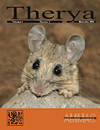
Vol. 1 No. 3 (2010)
The Slevin’s mouse inhabiting Santa Catarina Island (Peromyscus slevini) shown on the cover is a species endemic to an island in the Gulf of California (in the center of Baja California Sur). Some time ago, this species was considered as displaced by some individuals of Peromyscus fraterculus introduced from the mainland. Both species are currently found on the island. In the latest expeditions to the island, the species was spotted only in the deepest canyons and in lower numbers relative to P. fraterculus, a species introduced to the island from the mainland. This species is considered as endangered and is currently the subject of ecological and genetic studies (photograph by Sergio Ticul Alvarez Castaneda). -

Vol. 1 No. 2 (2010)
The black jackrabbit (Lepus insularis) of Espiritu Santo Island displayed on the cover is a species considered endemic to the island in the Gulf of California (southeastern of Baja California Sur). Individuals are associated with coastal scrub and chaparral vegetation. The species inhabits rocky areas and canyon slopes. It is not easy to see because its coloration resembles the substrate and also due to its ability to crouch when threatened. This species is considered as endangered and is currently undergoing ecological and genetic studies (photograph taken by Sergio Ticul Alvarez Castaneda). -
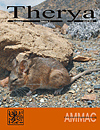
Vol. 1 No. 1 (2010)
The Bryan’s woodrat (Neotoma bryanti) of Cedros Island that is displayed on the cover is a species considered endemic to Cedros Island, in the Mexican Pacific, in southern Baja California. Individuals are associated with coastal scrubs and chaparral vegetation. Patton et al., 2008 (Univ. Cal. Pub. 135:1-411), in their review of the species in the group lepida, consider Neotoma bryanti as the nominal species that is distributed across most of the Baja California peninsula. N. bryanti has five subspecies, including N. anthonyi (N. b. anthonyi), a species endemic to Todos Santos Island, in front of Ensenada, Baja California. The population inhabiting Cedros Island becomes N. b. bryanti (photograph by Sergio Ticul Alvarez Castaneda).


